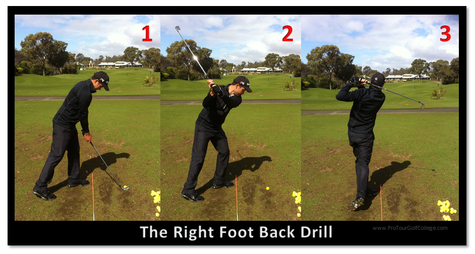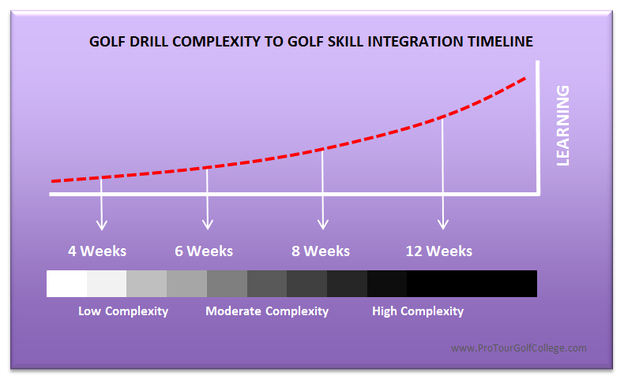"It’s a whole lot of moving parts that make up the whole, and your job is to learn, coordinate and synchronize those parts to work in harmony with one another to create a successful collision with a golf ball, that sends the ball on its way towards your target, many times over".  One of the biggest challenges you face as a an advanced or elite level golfer is to keep improving, and the most pressing issue you will face will be “staying the course,” or in other words, to keep pushing forwards when all you seem to experience each time you practice is set-back and a lack of progress. Now’s there’s nothing more frustrating than to practice golf drills or skills and not see the improvement that you expect. You are putting the hours in and you expect improvement, but when you go out to play and test it, you find that it hasn't improved. You can have the best self-talk skills in the world but that means nothing if you haven’t learned the golf skill or drill well enough to trust it. You see every time you play golf you are simply executing a whole range of specific behaviors that when put together over 9 or 18 holes amounts to your performance. The trouble is that it’s one thing to practice with the intention of improving a golf skill, and another to realize that your idea of when you should improve a part of a golf skill, and that of your nervous system is probably miles apart. Learning is remembering, and then ultimately memorizing, which is often described as the unconscious competence or autonomous stage of learning. It’s the “forget you know how to” stage of learning. Can you achieve an unconscious competence level with a flawed golf swing technique? You bet you can. You can master flawed techniques as easily as correct ones. So it’s important to learn golf skills carefully with accurate feedback from well designed practice drills and the most relevant training aids that ideally are recommended to you by your golf instructor or coach. This is so you can recall the movement patterns correctly and accurately every time you go to practice. All things being equal - the more practice (repetitions) of the drill or technique that you perform, the more learning that should result from it. Keep in mind though, that the more complex the drill you are performing (the more moving parts to coordinate), the longer it will take to integrate into your golf stroke pattern. For example, a slight grip change could be considered a low complexity change, and your new grip routine might take you 4 weeks or longer to integrate into your technique with daily repetitions performed correctly. A downswing drill on the other hand where you might be moving your right elbow more in-front of your right hip in the delivery position (higher complexity) might take a lot longer to integrate, and will require a lot more repetitions. One of our tour players we consult with has been working on a downswing to post-impact drill for more than 12 months and only recently is starting to trust the change when he competes in tournaments. The other thing to consider is that some parts of the whole technique will be more advanced along the learning pathway than others. As I mentioned, you have different parts that require more effort to integrate than other parts. Generally speaking, it is going to take more time than you think to improve all the parts that make up the whole. Think about it; what you are doing is practicing recall in the form of specific movement patterns or motion. That’s all a golf stroke is. It’s a whole lot of moving parts that make up the whole, and your job is to learn, coordinate and synchronize those parts to work in harmony with one another to create a successful collision with a golf ball, that sends the ball on its way towards your target, many times over.  But how do you manage the learning of all the parts that make up the whole? Let’s say that you have been to see your golf instructor and she/he has given you a drill, or some drills to work on to improve your golf swing, and now you have to allocate time out of your week to practice the drill. What is the best way to do this? Well, the way we suggest you do it is with the use of a Golf Drill Accountability Log that will keep you on-track with your goal of turning your golf practice drills into peak performance skills. Learning = Correct Practice Drill + Repetitions x Time This accountability log will help you to manage the amount of drill work you are performing, whether it’s a full swing drill or a short game drill. When you fill out the log you record data on how many repetitions you performed per practice session, and also the quality of the practice session, which is based on a quality scale from 1 to 7. If you want the drill you are practicing to stick, then you need to make sure that every time your perform repetitions of the drill, that you put all your focus into performing it exactly as it was taught to you by your instructor.
For every set of 10 repetitions of the drill, rate your level of performance from 1 to 7, with 7 being the best it can be performed, and 1 being the worst it can performed. If you just perform your drills in a random and haphazard way then it would be difficult to expect progress because there’s no way to know whether the drill is actually moving you closer to integration. The use of practice drills and training aids form an integral part of the golf improvement learning process. By carefully managing your expectations, and realizing that you have to learn the information so you can perform it at the unconscious competence level you will stay the course and be able to turn it loose in tournaments with confidence. Remember it always takes longer to learn in the body than it does to learn in the mind. Are you up to the challenge? Lawrie Montague and David Milne - Pro Tour Golf College Your Success On Tour is Our Business
Jonna
31/8/2013 02:45:04 pm
Hi, 1/9/2013 02:45:54 am
Hi Jonna,
Jonna
1/9/2013 11:36:41 am
It´s OK now, I had forgotten to restart after installing thw update. Comments are closed.
|
Archives
June 2019
|
Proudly Supported By
Copyright © 2011 - 2018 Pro Tour Golf College
Website Managed By Golf Performance Media
All Rights Reserved
Website Managed By Golf Performance Media
All Rights Reserved





 RSS Feed
RSS Feed



